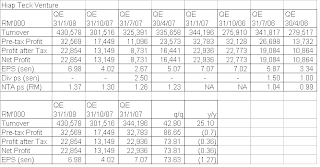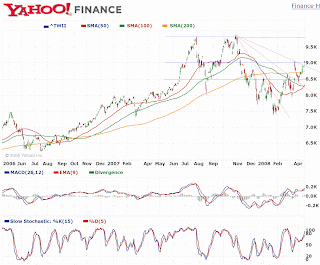Background
Natural Bio Resources Bhd ('Natbio') manufactures and distributes ready-to-drink coffee, tea and energy drinks under the brands
Power Root, Ali Café, Per’l Café and
Oligo Coco. It has 16 key dealers and a full-time marketing team of 59 people in
Malaysia. Natbio was listed only in May last year.
Recent Financial Results
As Natbio was listed recently, we only have 3 quarters' results to guide us. From the table below, we can that Natbio's turnover averages about RM45 million per quarter, while its quarterly net profit is about RM10 million. EPS for full year would probably amount to 14.4 sen.

Past Financial Results
From its Prospectus for listing, we can look at its financial performance prior to its listing (go
here). An extract is given below.

From the period from FY2004-2006, Natbio's turnover increased from RM12.7 million to RM98.0 million. Net profit jumped from RM458k to RM17.2 million. The sharp rise in its topline & bottomline may give rise to some concern whether they are sustainable. From the 3 available quarterly results, it seems that the company can maintain its growth.
Financial Position & Concerns
As at 31/11/2007, Natbio's current ratio & gearing ratio are at 9.1 times & 0.1 times, respectively. As such, Natbio's financial position is deemed very strong. Its Total Assets stood at RM230.8 million, which comprised Fixed Assets of RM44.6 million; Cash, Bank Balance & Fixed Deposits totaling RM86.6 million; Trade Debtors of RM54.7 million; and, Inventory of RM37.9 million. Trade Debtors' collection period & Inventory's turnover period were 110 & 76 days, respectively. I believe that the Trade Debtors & Inventory level is acceptable when we compare them with similar companies, such as Yeo Hiap Seng & Spritzer.

Valuation
Based on yesterday's closing price of RM0.81 & projected EPS of 14.4 sen, Natbio is trading at a PE of 5.6 times. As such, Natbio is deemed quite attractive.
Technical Outlook
Natbio made a high of RM1.97 in June last year. Since then, it has drifted lower & three weeks ago, it made a low of RM0.76. The share price appears to have broken to the upside of its downtrend line (marked as 'AA') in the past few days, on thin volume. As such, Natbio share price could have bottomed and a recovery may follow.
 Chart: Natbio's daily chart up to April 22nd (from Tradesignum.com)
Chart: Natbio's daily chart up to April 22nd (from Tradesignum.com)Conclusion
Natbio is quite attractive & the share price could have bottomed after a prolonged decline. It maybe a good BUY for the medium-term.




















































